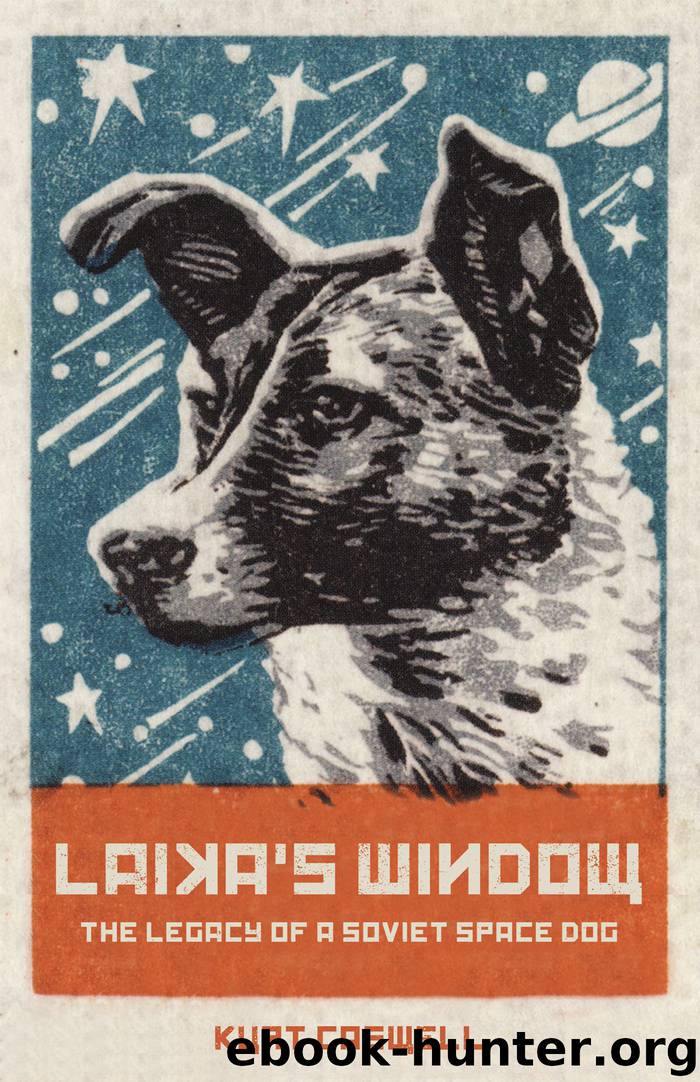Laika's Window by Kurt Caswell

Author:Kurt Caswell
Language: eng
Format: epub
Publisher: Trinity University Press
Published: 2018-10-27T16:00:00+00:00
FOUR
¤
Scouting the Atmosphere
Let the dog, man’s helper and friend since prehistoric times, be sacrificed for science. But our dignity obligates us to do this only when necessary and always without unnecessary torment.
IVAN PAVLOV
inscribed on the memorial to his lab dogs in
Saint Petersburg, early twentieth century
Between 1951 and 1966, the Soviet Union launched some forty-two rockets into space and into orbit carrying more than fifty different space dogs. Most flew in pairs, and with the exception of two dogs that each flew with a mannequin, Laika is the only dog who flew alone. Some dogs flew only once, because they were either killed or retired for some reason. Others flew multiple times, the record probably held by a dog named Otvazhnaya, or Brave One, who flew seven times.
Cataloging the flights of the space dogs is a difficult task, because some had more than one name. In fact, some of the scientists and engineers working on rockets and missiles also had alternative names to help hide their identities. If a dog died on a flight mission, a new dog might be given its name. Some of these dogs assuming the name of another were numbered in sequence, as in Fox and Fox 2, and some were not. The team might change a dog’s name from its first to its second flight, or change a dog’s name as it waited on the launchpad for liftoff. The two most reliable sources I found for the identification of the space dogs and their missions are Olesya Turkina’s Soviet Space Dogs, which includes a comprehensive list of space dog flights; and Animals in Space, by Colin Burgess and Chris Dubbs, who invested considerable time and effort in piecing together a chronology of the flights.
To better understand Laika’s story, a number of space dog flights deserve our attention, missions by some dogs who flew before her and some who flew after.
¤
Three hundred fifty kilometers up the Volga River from its delta at the Caspian Sea is the site of the Soviet Union’s once secret military missile test center, Kapustin Yar. Backed by the vegetated green of the great Volga’s braided channels, the test center faces eastward onto a vast system of dunes and wastes, the Ryn Desert stretching some six hundred kilometers into western Kazakhstan. Temperatures here can reach highs of 45 degrees Celsius in summer and lows of –35 degrees Celsius in winter. It is a windswept and arid land, empty of people but for a few scattered villages and towns. Kapustin Yar is not so secret anymore, but at its genesis in 1946 it was central to the Soviet Union’s covert missile program and the site of the first suborbital space dog launches.
On July 22, 1951, the first two space dogs—Dezik and Tysgan—were launched into the upper atmosphere from Kapustin Yar. Laika had yet to be born, and while putting a satellite into orbit, followed by a dog and eventually a man, was the dream of some engineers and scientists, it was yet far from possible.
Download
This site does not store any files on its server. We only index and link to content provided by other sites. Please contact the content providers to delete copyright contents if any and email us, we'll remove relevant links or contents immediately.
| Aerodynamics | Aircraft Design & Construction |
| Astronautics & Space Flight | Avionics |
| Gas Dynamics | Propulsion Technology |
Whiskies Galore by Ian Buxton(41879)
Introduction to Aircraft Design (Cambridge Aerospace Series) by John P. Fielding(33064)
Small Unmanned Fixed-wing Aircraft Design by Andrew J. Keane Andras Sobester James P. Scanlan & András Sóbester & James P. Scanlan(32743)
Craft Beer for the Homebrewer by Michael Agnew(18140)
Turbulence by E. J. Noyes(7935)
The Complete Stick Figure Physics Tutorials by Allen Sarah(7307)
Kaplan MCAT General Chemistry Review by Kaplan(6866)
The Thirst by Nesbo Jo(6826)
Bad Blood by John Carreyrou(6552)
Modelling of Convective Heat and Mass Transfer in Rotating Flows by Igor V. Shevchuk(6391)
Learning SQL by Alan Beaulieu(6209)
Weapons of Math Destruction by Cathy O'Neil(6142)
Man-made Catastrophes and Risk Information Concealment by Dmitry Chernov & Didier Sornette(5921)
Digital Minimalism by Cal Newport;(5663)
Life 3.0: Being Human in the Age of Artificial Intelligence by Tegmark Max(5474)
iGen by Jean M. Twenge(5366)
Secrets of Antigravity Propulsion: Tesla, UFOs, and Classified Aerospace Technology by Ph.D. Paul A. Laviolette(5309)
Design of Trajectory Optimization Approach for Space Maneuver Vehicle Skip Entry Problems by Runqi Chai & Al Savvaris & Antonios Tsourdos & Senchun Chai(5011)
Pale Blue Dot by Carl Sagan(4912)
